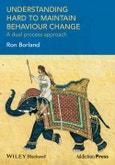The book presents an integrative theory of hard-to-maintain behaviours, that includes hard-to-reduce or eliminate behaviours like smoking and other drug use, overconsumption of food or unsafe sex, and hard-to-sustain behaviours like exercise and sun-safe behaviours. Most of the examples come from the author’s work on tobacco smoking, but it is relevant to anyone who is concerned to understand why some forms of desirable behaviour are so hard to achieve, and to those trying to help people change. It also has important implications for public health campaigns and for the development of policies to nudge behaviour in desirable ways.
The book provides readers with frameworks to:
- Determine whether a “hard to maintain” behaviour is a result of the skills needed to perform it, its reinforcement history, the way the person thinks about it, the context, or some combination of these.
- Better integrate cognitive and behavioural change strategies, including emergent strategies related to mindfulness and acceptance, plus novel ways of retraining operational processes.
- Understand the different nature of challenges for behaviours where multiple attempts are typically required before the desired behaviour pattern is sustained.
- Better understand the role of feelings and emotions as influences on behaviour.
- Understand the limits of environmental factors to determine change.
- Understand the limits of self-control and will-power.
Table of Contents
Preface ix
Acknowledgements xi
1 An overview of the theory 1
Context 4
Limitations of the existing theories 5
Core elements of CEOS 12
Conceptual underpinnings 14
The generation of behaviour 17
Capacity of the ES 19
Initiation versus maintenance of behaviour 20
The relationships between the two systems 21
Story creation within the ES 22
Biological constraints 22
Elaboration of CEOS theory 24
References 26
2 Characteristics of hard-to-maintain behaviours 31
Types of behaviour to change 31
What makes some behaviours hard to maintain? 34
Hard-to-reduce/resist/eliminate behaviours 37
Addictions versus other HTR behaviours 38
The example of smoking 40
Hard-to-sustain behaviours 44
Examples of HTS behaviours 45
Combinations of both kinds of behaviour change 46
Replacements and substitutes 47
What is learnt in HTM behaviour change 48
References 50
3 The roles of the operational and executive systems 54
The Operational System 55
The nature of the Operational System 55
Functions of the Operational System 60
Modifying OS functions 62
The Executive System 65
Core capacities of the ES 66
Inputs to the ES 69
Stories and the roles they play 72
What the ES can do 75
Limitations of thinking 81
Self-regulation 85
The stability of change 86
Relationship of CEOS to other dual-process theories 86
References 94
4 Environmental influences: the context of change 98
The relatively stable environment 99
The social environment and social norms 102
Modelling and vicarious learning 103
Changing the broader environment 104
Regulation and legislation 106
Public education 109
The interactional environment 110
Requisites for behaviour 110
Interpersonal influences 111
References 114
5 Conceptual influences on change 117
Framing the problem 118
Message framing 120
Mechanisms of persuasion 122
Organisation of concepts about change 125
Core beliefs and values 126
The desirability of change 127
Influences on goal desirability 127
Priority 130
Decisional balance 131
Goal achievability 133
Analysis of the challenge (task difficulty) 133
Self-efficacy 135
Beliefs that can interfere with behaviour change 137
References 139
6 The structure of the change process 142
Tasks involved in behaviour change 143
Getting behaviour change on the agenda 145
Goals 146
Making an attempt to change 148
Scripts 152
Commitments to change 154
Maintaining change: perseverance 155
Determinants of maintenance/relapse 159
Drivers of relapse 160
Maintaining appropriate beliefs 161
Influences on self-control 163
Influences on reorienting the OS 164
Recovering from setbacks 165
Feedback and evaluation 166
Repeated attempts are the norm 167
Hardening: the changing nature of the population who have not changed 169
References 171
7 Interventions for behaviour change 176
Internal and external perspectives on change 177
Differences between HTR and HTS behaviours 178
Enhancing executive function: optimising understanding 180
Framing: defining the problem and options for change 180
Feedback and evaluation 182
Making relevant knowledge salient 183
The occasional value of biases 185
Enhancing self-control 186
Enhancing executive functions 187
Managing and prioritising life challenges 188
Implementation intentions 189
Enhancing self-reorientation 190
Mindfulness and awareness 190
Acceptance 191
Understanding emotions and attitudes 193
Reconditioning the Operational System 194
Targeting alternatives to the desired behaviour 196
Practice 196
Use of drug therapies 197
Creating more supportive environments 197
Changing the pattern of cues to act 197
Rewards and other motivators 198
Understanding communication 198
Externalising self-control 199
The availability of what is required 200
Advocating for change 200
Integrative strategies 201
Building a revised sense of self 201
Improving recovery from setbacks 202
Optimising a script or plan for action 202
References 205
8 Using CEOS to advance knowledge 209
Key features of CEOS theory 209
Reframing thinking 211
Key questions to answer for behaviour change 213
Contributions of different kinds of research 213
Measuring key constructs 215
Measuring ES influences on behaviour 217
Measures of OS influences on behaviour 218
Measures of context 219
Elements of a theory-driven research agenda 220
Comparisons with other theories 221
Implications for reducing inequities 226
Concluding comments 227
References 229
Index 233







